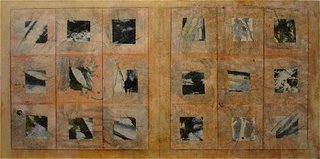 Bokusho-Kin, 24x48, 2006
Bokusho-Kin, 24x48, 2006I like that I'm really focused on doing just one thing right now. Granted a request for more and bigger landscapes entered the picture, but that will have to wait. I've had times when I focused on landscapes and maybe created a signature style of sorts, but I sure didn't feel about them the way I feel about the bokushos. I have a number of works in process, some have been labeled 'finished' several times but as I explore other ways to apply the paper/marks with assorted gels and mediums, I must go back and improve' the previous works. And it goes round and round...
 (enlarge this partial image to see surface details)
(enlarge this partial image to see surface details)In this piece, kin means quilt in Japanese, the pieces are layered, reversed large squares first, smaller squares on top after plain paper was used as a glaze overall. Lots of faint color glazing and ruled as well as gestural lines applied. The first to define, the second to tie down the small squares which were too distinct without some interference.
I'm finding I prefer using old paintings to raw canvas to begin the applications. The raw canvas is way too pure in both texture and color. I find I can't turn my back on years of textural applications, especially when it adds surprising pentimento in, often, just the right place. I have to go with it. One of the early hopes would be that I could short-cut some of the prep work that has gone into my paintings for years, but it's too much a part of what I do... the work looks cheap and unfinished without it.
I'm working on updating my website to include more recent work with a separate page for the bokushos (and one for the landscapes as well.) Updating web pages isn't nearly as much fun as blogging. On another note, I've made several attempts at reordering the original rice paper I used in France (it's magic!) but they only take charge cards via PayPal. Well, when PP was having all that hacking trouble and I was getting two or three requests a week from bogus companies claiming to be PP, I just began ignoring them. Well... I guess one or two of the requests were legitimate and now they won't let me in since I didn't update, or some such. They can jump in a lake (had to think a minute to clean that up) I sent a check snail mail. Man, that paper better still be magic! I told the Asian propriator about my PP problems. I don't like to be told my plastic is no good at that store! My plastic is GOOD!
My visiting cousin and I will be tripping down to Panama City Beach tomorrow (not my favorite city) to pay a call on an uncle who really is a favorite. It might have been his sailor suit I fell in love with at age 4, but whatever, it's been lasting. See ya on the other side...

6 comments:
Oh I so wish I could look at this really close up! Is there any way that you could post it (or a part of it) much bigger? Even the 'click on' view doesn't show it very well.
It is fascinating.
I agree, the image I put up doesn't begin to show the surface detail... I've added another which can be enlarged. Also lightened and sharpened a bit. I admit to getting lazy with my documentation photos and don't always use good lighting, depending on photo editing to make them somewhat close. KJ
Karen, I've been enjoying your blog and your web site. I asked a Japanese friend to clarify the meaning of "bokushu" for me, and thought you might enjoy her answer:
"Bokusho" is general word. Boku = sumi, is the same Chinese character, and
boku is Chinese sound (for Japanese, not exactly Chinese), sumi is Japanese
sound. Sho means writing. It's not the term for art. We usually use
mou-hitsu to mean sumi writing. Mou is hair, and hitsu is brush. Sumie is
sumi ink painting, e is painting. Suiboku-ga, also sumi ink painting, was
created in China in 7th century, descended to Japan in 12th century. It took
place relating to zen taste in Japan for its cool tone of variety of
blacks.
She uses it as her original, I guess, but it's totally ok for Japanese.
I do like her work, too. I liked her squares and collage. I found the title
"obi", and your pathway series recalled us obi. Thanks for sending that to
me.
Naomi
----- Original Message -----
From: derbesm@bellsouth.net
To: amiedecheval@sun.email.ne.jp
Sent: Friday, August 25, 2006 4:10 AM
Subject: Bokusho
> Good morning, Naomi-san.
>
> Do you know anything about the term "bokusho"?
>
> It's used on the web site of an artist that I like:
> http://karenjacobs.com/
>
> But I wonder about the exact meaning of the term. I haven't found anything
helpful on Google.
>
> Mary
>
Oh, wow! This is exactly what I love about the Internet! Thanks so much for making the inquiry and thanks to Naomi for helping to define the word. It doesn't seem to be a widely used term but I first found it documented here: http://artweb.entanet.com/shingo/english/sumi.phtml
(scroll down about half way to 'terms'.)I varified it with a few other sources on the web but unfortunately, didn't bookmark them. If anyone can find other references to bokusho, I'd love to see.
Karen - It's great to see your enthusiasm for this new series. You were looking for a new direction, and I'm happy to see your passion return. Robin
Karen, even yho I miss the red barn pait, I am very much enjoying watching your process with the bokusho. You really have something here.
Post a Comment